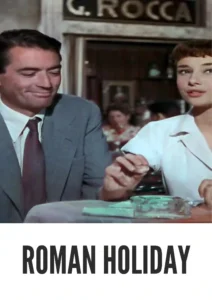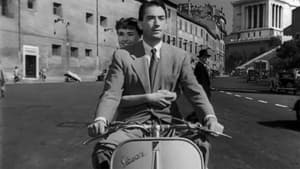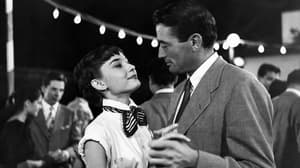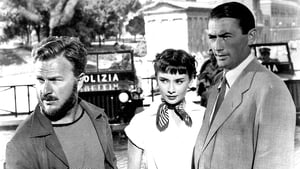Video Sources 0 Views
- Watch trailer
- Roman Holiday 1953 Colorized


Synopsis
Table of Contents
Toggle
Embark on a cinematic journey with Roman Holiday, the enchanting romantic comedy from 1953, now beautifully colorized to capture the timeless allure of Rome and the blossoming romance between a princess and a journalist. Starring Gregory Peck and Audrey Hepburn, this film transcends generations with its heartwarming story, captivating performances, and picturesque backdrop. Perfect for fans of classic cinema and those seeking a touch of romance and escapism, this HD download offers a fresh perspective on a beloved masterpiece.
Roman Holiday tells the story of Princess Ann (Audrey Hepburn), a young royal weary of her regimented life and suffocating schedule. During a diplomatic tour of Europe, she arrives in Rome and, overwhelmed by her responsibilities, sneaks out one night to experience the city as an ordinary person.
While wandering the streets, she meets Joe Bradley (Gregory Peck), an American journalist down on his luck. Unaware of Ann’s true identity, Joe takes her back to his apartment to sleep off what he assumes is a drunken stupor. The next morning, after realizing who she is, Joe sees an opportunity for an exclusive story and, along with his photographer friend Irving Radovich (Eddie Albert), pretends to be a helpful acquaintance, all while secretly documenting her Roman adventure.
As Ann and Joe explore Rome together, they fall in love, sharing laughter, secrets, and unforgettable moments. Ann revels in her newfound freedom, experiencing the simple pleasures of life, while Joe finds himself torn between his journalistic ambitions and his genuine feelings for the princess.
The film culminates in a poignant farewell, as Ann returns to her royal duties, forever changed by her Roman holiday, and Joe decides to forgo his story out of respect for her. Roman Holiday is a touching and timeless tale about love, freedom, and the magic of unexpected encounters.
The film boasts a stellar cast, whose performances elevate the film to iconic status:
-
Gregory Peck as Joe Bradley
-
Audrey Hepburn as Princess Ann
-
Eddie Albert as Irving Radovich
-
Hartley Power as Mr. Hennessy
-
Harcourt Williams as Ambassador
Roman Holiday effortlessly blends the genres of romantic comedy and coming-of-age story, set against the backdrop of post-war Rome. Its lighthearted humor, genuine emotion, and charming characters make it a beloved classic that continues to resonate with audiences of all ages.
Released in 1953, Roman Holiday captures the allure of post-war Italy, showcasing the beauty and vibrancy of Rome as it emerged from the shadow of World War II. The film also reflects the glamour of Hollywood’s Golden Age, with its charismatic stars, elegant costumes, and sophisticated storytelling. Roman Holiday not only entertained audiences but also contributed to the popular image of Rome as a romantic and enchanting destination, attracting tourists from around the world. The movie marked Audrey Hepburn’s breakout role, solidifying her status as a major star and fashion icon.
This colorized version of Roman Holiday has been meticulously crafted using state-of-the-art digital technology, breathing new life into the classic black and white film. The colorization process involved extensive research and careful attention to detail, ensuring that the colors accurately reflect the film’s original setting and atmosphere. The team of specialists used advanced software to enhance the visual quality, bringing out the richness and vibrancy of the Roman landscapes and the characters’ costumes. While some purists may prefer the original black and white version, the colorized edition offers a fresh and engaging viewing experience, appealing to a wider audience and introducing a new generation to the magic of Roman Holiday.
-
: William Wyler
-
: Dalton Trumbo (fronted by Ian McLellan Hunter and John Dighton)
-
: Dalton Trumbo
-
: Frank F. Planer, Henri Alekan
-
: Robert Swink
-
: Paramount Pictures
-
: Paramount Pictures
-
: 118 minutes
-
: MP4
-
: HD (1080p)
-
: Compatible with most devices, including smartphones, tablets, computers, and smart TVs.
Roman Holiday is widely regarded as a cinematic masterpiece, earning critical acclaim and numerous awards, including three Academy Awards (Best Actress for Audrey Hepburn, Best Writing – Motion Picture Story, and Best Costume Design – Black-and-White). The film’s enduring popularity is a testament to its timeless story, unforgettable performances, and exquisite direction. Critics have praised the film’s charming humor, heartfelt emotion, and authentic portrayal of Rome, making it a beloved classic for audiences around the world.
-
: What is Roman Holiday about?
-
A: Roman Holiday is a romantic comedy about a princess who escapes her royal duties and falls in love with an American journalist in Rome.
-
-
: Why is Roman Holiday considered a classic film?
-
A: Roman Holiday is considered a classic due to its timeless story, unforgettable performances by Gregory Peck and Audrey Hepburn, and its charming depiction of Rome.
-
-
: Is this version of Roman Holiday colorized?
-
A: Yes, this version has been professionally colorized to enhance the viewing experience.
-
-
: What makes Roman Holiday appealing to modern audiences?
-
A: Roman Holiday‘s themes of love, freedom, and self-discovery continue to resonate with audiences, while its beautiful scenery and captivating performances make it a timeless classic.
-
-
: What is the download format?
-
A: The download format is MP4, which is compatible with most devices.
-
-
: What resolution is the download?
-
A: The resolution is HD (1080p), providing a high-quality viewing experience.
-
Watch Roman Holiday Today!




















